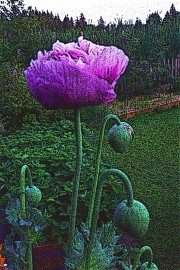Life at the Lake
a diary of living at a small lowland lakeWHAT IT'S LIKE

Early moonrise over Lake Ketchum
|
Archive Search |
| Links |
|
and s-integrator |
WHAT IS LEFT OF THE POPPIES NOW . . .

No more
329
What is left of the poppies, now that it is August, is the individual mummies of what once were huge, magnificent blooms—tall clusters of them. But, hey, they are beautiful in themselves.
The dry brown shards of blooms and leaves are falling away, to leave the seed pods brittle and hard-as-dirt clods. Shake them hard and brush them with your hand and you have dried bouquets of graceful stalks and stems. They are very tall and light in weight, so if you put them into a vase you will have to add stones or glass beads to the bottom to keep the bouquet from tipping over.
That's okay. What you will have is an arrangement that will last indefinitely, surely through the coming winter, when there will be no fresh flowers for the table.
- - Comments ()
...
WHAZZ THIS?

Does this look Chinese to you? Good! It should!
327
It is Chinese calligraphy we are learning, stroke by stroke. And there are a lot of them. This is a sample worksheet from Johan Bjorksten's excellent book, Learn to Write Chinese Characters, Yale, 1994.
Yes, I did it.
Written correctly, the characters are graceful and beautiful. Mine are not, not yet, but I am making progress in that direction. And yesterday I think I got it. Got it right, that is, for I can now look at most characters (especially the abbreviated ones), see the stroke order (which is fixed and inflexible), and without looking back at the character draw it.
Okay, so I do look back still, once or twice per most complex characters, but I am drawing much more rapidly and smoothly than even a day ago. And this is very satisfying. Late yesterday afternoon I was all grins.
Four lines up from the bottom grid (all characters should be drawn in square boxes, until the box format becomes ingrained) is a poem, "A Thought on a Still Night" from Li Bai, who died in 762 AD. I've read it in translation (much lost there) and now I've written it, but not yet in the correct poetic format. That will come soon—when I can create in MS Word Tables the right grid boxes, which ought to be fairly simple to do. The characters will be more difficult to form prettily.
I am looking forward to trying to do it.
Oh, the method recommended by Bjorksten is called "fountain pen calligraphy," and mine is done with a cartridge-fed Sheaffer pen on ordinary white paper. It can also be done with a bamboo brush, and is even more beautiful.
I have a ways to go before I try this.
- - Comments ()
...